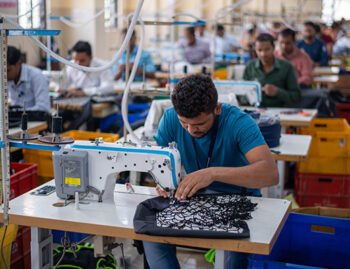 Though India’s textile and apparel market was affected as manufacturing and exports of essential goods and services were prioritised by all countries in the wake of the ongoing COVID-19 pandemic, signs of recovery are visible in 2021-22, according to the Export Preparedness Index (EPI) 2021 released recently by NITI Aayog and the Institute of Competitiveness.
Though India’s textile and apparel market was affected as manufacturing and exports of essential goods and services were prioritised by all countries in the wake of the ongoing COVID-19 pandemic, signs of recovery are visible in 2021-22, according to the Export Preparedness Index (EPI) 2021 released recently by NITI Aayog and the Institute of Competitiveness.
Rising consumer demand and the government’s increased efforts to boost the textile-garment sector have led to the textile sector maintaining a trade surplus in India’s export basket, it said.
The year-on-year (YoY) growth in textile products increased to 53.86 percent in April-November 2021, which shows robust growth signals. Cotton fabrics, made-ups and readymade garments of cotton, including accessories, have driven the exports.
The government has also achieved 68 percent of the annual target of $44 bn for textiles and apparel, including handicrafts, in 2021-22, the document said.
EPI 2021 brings out three major challenges to India’s export promotion. These are intra- and inter-regional differences in export infrastructure; weak trade support and growth orientation across states; and lack of research and development infrastructure to promote complex and unique exports.
It noted that India has not fully exploited the Lewis curve for low-skill manufacturing compared with more skill-intensive exports. Low or unskilled exports include those of apparel, textiles, leather and footwear.
Since the nation has a comparative advantage in low skilled exports, it must boost its manufacturing capacity to further exploit this opportunity, the document noted. India lags behind to tap on existing market potential in contrast with Vietnam, Bangladesh and China, which continue to lead exports in this category, it observed.
The report is a comprehensive analysis of India’s export achievements. The index can be used by states and union territories to benchmark their performance against their peers and analyse potential challenges to develop better policy mechanisms to foster export-led growth at the sub-national level.
The Export Preparedness Index is a data-driven endeavour to identify the fundamental areas critical for subnational export promotion.
The EPI ranks states and union territories on four main pillars—policy, business ecosystem, export ecosystem and export performance—and 11 sub-pillars—export promotion policy, institutional framework, business environment, infrastructure, transport connectivity, access to finance, export infrastructure, trade support, research and development infrastructure, export diversification, and growth orientation.










